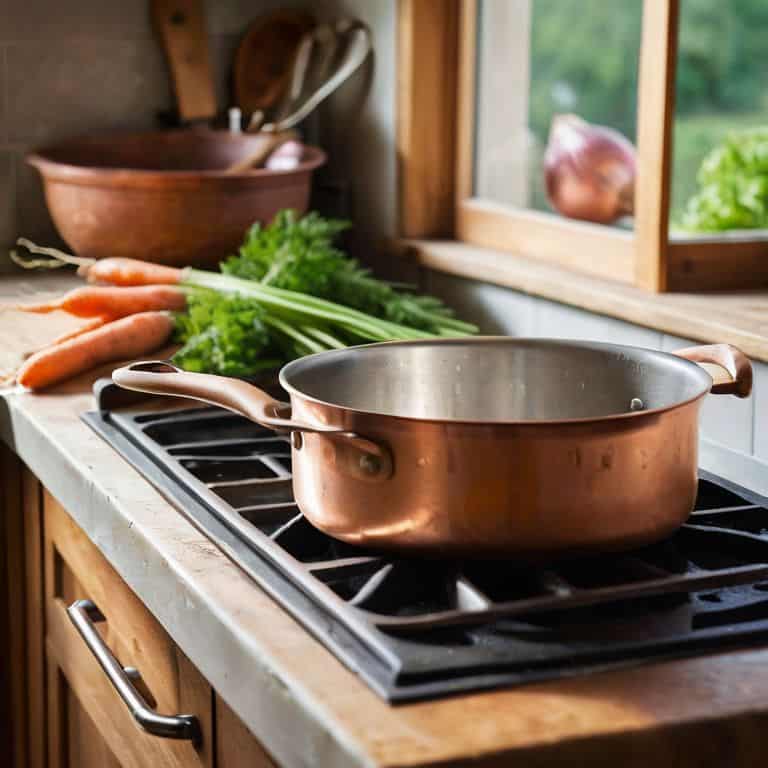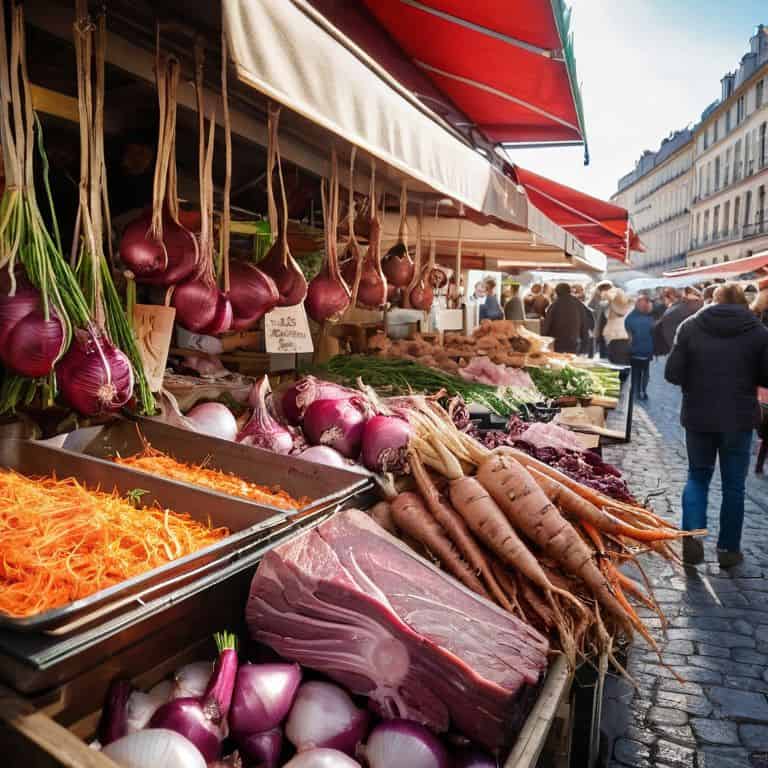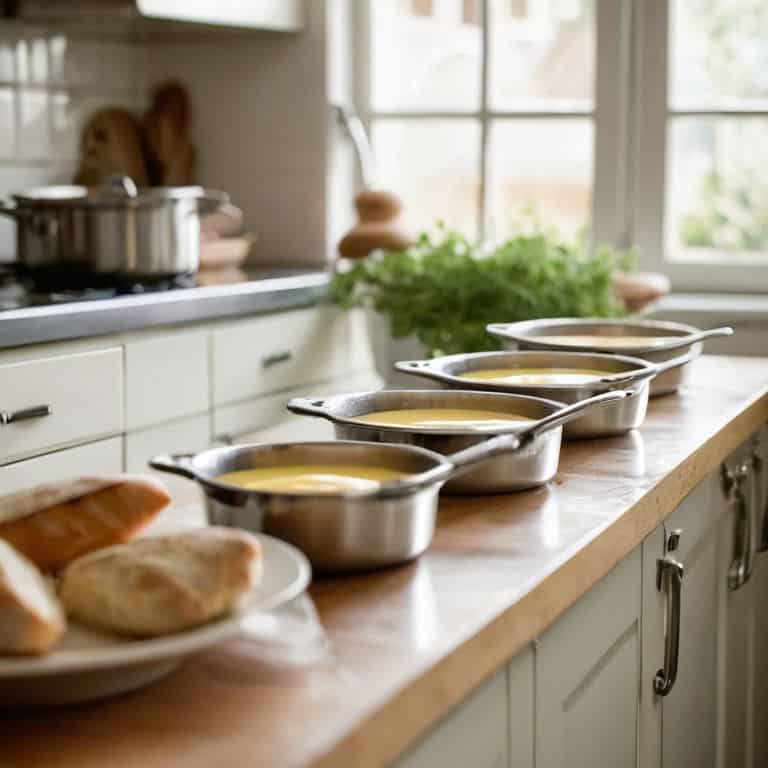I still remember the first time I stumbled upon a tiny Parisian bistro, where the chef taught me that mastering a guide to the five french mother sauces is like unlocking a treasure chest of flavors – it’s a game-changer for any home cook! The idea that these sauces are only for fancy restaurants is a myth that has been debunked by every grandmother and street food vendor I’ve met on my travels. As I delved deeper into the world of French cuisine, I realized that understanding the basics of these mother sauces is the key to creating a wide range of dishes, from simple to complex.
In this article, I’ll share my personal experience and knowledge to provide you with a practical guide to mastering the five French mother sauces. You’ll learn how to prepare each sauce from scratch, using traditional techniques and ingredients, and how to apply them to various dishes. My goal is to empower you with the confidence to experiment and create your own recipes, just like the chefs and home cooks I’ve met on my travels. By the end of this guide, you’ll be equipped with the skills to elevate your cooking and bring a taste of France into your own kitchen.
Table of Contents
- Guide Overview: What You'll Need
- Step-by-Step Instructions
- Saucy Secrets a Guide to the Five French Mother Sauces
- Savvy Sauce Making: 5 Essential Tips for Mastering the French Mother Sauces
- Savoring the Essentials: 3 Key Takeaways
- Savoring the Essence of French Cuisine
- Savoring the Flavors of France
- Frequently Asked Questions
Guide Overview: What You'll Need

Total Time: 2 hours 30 minutes
Estimated Cost: $20 – $50
Difficulty Level: Intermediate
Tools Required
- Saucepan (stainless steel or enamel-coated cast iron)
- Whisk (balloon whisk or flat whisk)
- Measuring Cups (dry and liquid)
- Measuring Spoons
Supplies & Materials
- Butter (unsalted, 4 tablespoons)
- All-Purpose Flour (2 cups)
- Milk (2 cups, whole, low-fat or nonfat)
- Beef or Chicken Broth (4 cups)
- Tomato Puree (2 cups, canned or fresh)
- Egg Yolks (4 large, room temperature)
- Lemon Juice (2 tablespoons, freshly squeezed)
- Salt
- Pepper
Step-by-Step Instructions
- 1. First, let’s start with the foundation of all the mother sauces: a good roux. To make a roux, you’ll need to melt 2 tablespoons of butter in a saucepan over medium heat. Once the butter has melted, add 2 tablespoons of all-purpose flour and whisk until the mixture is smooth and free of lumps. Cook the roux for about 5 minutes, stirring constantly, until it reaches a light blond color and has a nutty aroma.
- 2. Now that we have our roux, let’s move on to the first of the five mother sauces: Béchamel. To make a Béchamel sauce, you’ll need to slowly pour in 1 cup of milk, whisking constantly to avoid lumps. Bring the mixture to a simmer and cook for about 10 minutes, stirring occasionally, until it thickens and coats the back of a spoon. Season with salt, pepper, and a pinch of nutmeg to give it a unique flavor.
- 3. The second mother sauce is Velouté, which is made by enriching a light chicken or fish stock with our trusty roux and some heavy cream. Start by heating 1 cup of stock in a saucepan until it’s hot but not boiling. Then, whisk in 2 tablespoons of our pre-made roux and cook for about 5 minutes, stirring constantly, until the mixture thickens. Finally, stir in 1/4 cup of heavy cream and reduce the heat to a simmer, letting it cook for another 5 minutes until it reaches the desired consistency.
- 4. Next up is the Espagnole sauce, which is often considered the most complex of the five mother sauces. To make an Espagnole, you’ll need to start by browning 1 cup of beef or veal bones in the oven until they’re nicely caramelized. Then, deglaze the bones with 1 cup of red wine, scraping up all the browned bits from the bottom of the pan. Add 2 cups of beef stock, 1 tablespoon of tomato paste, and 2 tablespoons of our roux, whisking until the mixture is smooth. Bring the mixture to a boil, then reduce the heat to a simmer and let it cook for about 20 minutes, stirring occasionally, until it thickens and reduces.
- 5. The fourth mother sauce is Hollandaise, which is made by emulsifying egg yolks with butter and lemon juice. Start by whisking together 3 egg yolks and 1 tablespoon of lemon juice in a heatproof bowl until they’re smooth and pale. Then, melt 1/2 cup of butter in a saucepan over low heat, whisking it into the egg yolks a little at a time. Temper the mixture by slowly pouring it into a bowl of ice water, whisking constantly, until it thickens and emulsifies.
- 6. Finally, we have the Tomate sauce, which is made by cooking down fresh tomatoes with our trusty roux and some aromatics. Start by heating 2 tablespoons of olive oil in a saucepan over medium heat. Add 1 onion, diced, and 2 cloves of garlic, minced, and cook until they’re softened and translucent. Then, add 2 cups of chopped fresh tomatoes, 1 tablespoon of our roux, and 1 cup of chicken or vegetable stock. Bring the mixture to a boil, then reduce the heat to a simmer and let it cook for about 20 minutes, stirring occasionally, until it thickens and reduces.
- 7. To finish and serve our mother sauces, we can use them as a base for a variety of dishes. Try serving the Béchamel sauce over steamed vegetables, or using the Velouté sauce as a base for a creamy chicken or fish soup. The Espagnole sauce makes a great accompaniment to grilled meats, while the Hollandaise sauce is perfect for topping eggs Benedict or steamed asparagus. Finally, the Tomate sauce is a great base for a variety of Italian-inspired dishes, from pasta sauces to pizza toppings. Experiment with different combinations to find your favorite ways to use these versatile sauces.
Saucy Secrets a Guide to the Five French Mother Sauces

As I delved deeper into the world of French sauce making techniques, I discovered that mastering the five mother sauces is just the beginning. One of the most crucial aspects of creating a rich and flavorful sauce espagnole is the quality of the ingredients used. I recall a visit to a small market in Lyon, where I met a local vendor who shared with me the secret to selecting the perfect _classic French cuisine ingredients_. From the sweetness of the onions to the richness of the beef broth, every component plays a vital role in creating a truly authentic sauce.
When it comes to _emulsion sauce stability tips_, I’ve found that patience and practice are key. One of my favorite memories is of a cooking class I took in Paris, where the instructor taught us how to create a perfectly balanced hollandaise sauce. The trick, she revealed, lies in the gentle whisking of the eggs and the gradual addition of the butter. It’s a technique that requires finesse, but the end result is well worth the effort. With these tips and tricks, even beginners can create delicious _mother sauce recipes_ that will elevate their cooking to the next level.
In many _french culinary school curriculum_, the art of sauce making is considered a fundamental skill. And for good reason – a well-crafted sauce can transform a simple dish into a culinary masterpiece. As I continued to explore the world of French cuisine, I began to appreciate the beauty of sauce variations, from the subtle nuances of a well-made _sauce espagnole_ to the rich, creamy texture of a perfectly balanced emulsion sauce. With each new discovery, my passion for French sauce making only grew stronger, and I became determined to share these secrets with fellow food enthusiasts.
Demystifying Mother Sauce Recipes for Beginners
As I sat in a small kitchen in Lyon, watching a French grandmother whip up a Béchamel sauce with ease, I realized that these mother sauces aren’t as intimidating as they seem. With a few simple ingredients and some patience, anyone can master them. I’ve found that the key to demystifying these recipes is to understand the basic components and techniques involved. By breaking down each sauce into its fundamental parts, beginners can start to see the similarities and patterns that underlie French sauce making.
For instance, a good roux is the foundation of many mother sauces, and learning to make one is a crucial step in unlocking the secrets of French cuisine. With a little practice, you’ll be making silky smooth sauces like a pro, and experimenting with new flavors and ingredients to create your own signature dishes.
Unleashing French Sauce Making Techniques
As I delved deeper into the world of French sauce making, I discovered that it’s not just about following a recipe, but about mastering techniques that elevate each sauce to new heights. I recall a cooking class in Lyon where I learned the art of reducing stocks to create rich, velvety textures. This simple yet powerful technique is the backbone of many French mother sauces. By applying this skill, home cooks can transform humble ingredients into extraordinary dishes.
With practice, I found that these techniques become second nature, allowing me to experiment with innovative flavor combinations. Whether it’s emulsifying eggs and butter or whisking in a roux, each method requires patience, attention to detail, and a willingness to take risks. As I continue to explore the world of French sauce making, I’m excited to share these techniques with fellow culinary adventurers, empowering them to unlock the full potential of these legendary sauces.
Savvy Sauce Making: 5 Essential Tips for Mastering the French Mother Sauces
- I still recall my time in Lyon, where I learned that using high-quality ingredients, like fresh vegetables and rich stocks, is the foundation of creating exceptional French mother sauces
- Balancing flavors is an art – I’ve found that tasting and adjusting as you go is crucial, just like Madame Dupont taught me in her tiny Parisian kitchen
- Don’t be afraid to experiment with the mother sauces – I’ve had incredible results adding a splash of wine or a pinch of spice to give them a personal touch, just like the street food vendors in Marseille
- Roux is the backbone of many French sauces, so it’s essential to master the technique of making a smooth, lump-free roux, which I learned from a charming grandmother in Bordeaux
- Practice, practice, practice – the more you cook with the French mother sauces, the more comfortable you’ll become with improvising and combining them to create something truly unique, just like the chefs I’ve met on my travels
Savoring the Essentials: 3 Key Takeaways
I’ve found that mastering the five French mother sauces is a powerful way to elevate your cooking, as each sauce serves as a foundation for countless derivative sauces, allowing you to create a wide variety of dishes with a few fundamental techniques.
Through my culinary journeys, I’ve learned that the true magic of French sauce making lies not just in the recipes, but in understanding how to balance flavors, a skill that requires patience, practice, and a willingness to experiment with different ingredients and seasoning.
Whether you’re a seasoned chef or a curious beginner, the art of crafting French mother sauces is an invitation to explore the rich culinary heritage of France, to innovate, and to bring a taste of authentic French cuisine into your own kitchen, one delicious sauce at a time.
Savoring the Essence of French Cuisine
The five French mother sauces are more than just a foundation of culinary technique – they’re a gateway to the soul of French cooking, a whispered promise of rich flavors and unforgettable memories, waiting to be unlocked by any cook brave enough to stir the pot.
Marco Bianchi
Savoring the Flavors of France

As I reflect on my journey through the world of French mother sauces, I’m reminded of the importance of mastering these fundamental recipes. From the rich, velvety texture of Béchamel to the tangy, slightly sweet flavor of Hollandaise, each sauce has its own unique character and story to tell. By grasping the techniques and ingredients behind these five legendary sauces, home cooks can unlock a world of culinary possibilities and elevate their dishes to new heights. Whether you’re a seasoned chef or a curious beginner, the art of French sauce making is sure to inspire and delight.
As you embark on your own culinary adventure, I encourage you to experiment and innovate with the French mother sauces. Don’t be afraid to add your own twist and creativity to these timeless recipes, and remember that the true magic happens when you combine technique with passion and curiosity. As I always say, the best recipes are those that are shared and passed down through generations, and I hope that this guide has inspired you to join the conversation and share your own saucy secrets with the world. Bon appétit, and happy cooking!
Frequently Asked Questions
What are some common mistakes to avoid when making the five French mother sauces?
I’ve seen many a novice cook fall into the trap of over-reducing or under-seasoning their mother sauces. Don’t be afraid to taste as you go and adjust the seasoning. Also, never skip the roux-making step, it’s the foundation of a rich, velvety sauce. And remember, practice makes perfect, so don’t be discouraged if your first attempts don’t turn out exactly as you hoped.
Can I substitute or omit certain ingredients in the mother sauce recipes without compromising the flavor?
Ah, the age-old question of substitutions! I’ve learned from grand-mères around the world that a little flexibility is okay, but some ingredients are sacrosanct. For the mother sauces, it’s best to stick with the core ingredients, but feel free to swap out minor components, like shallots for onions or parsley for chives – just be sure to taste as you go and adjust accordingly.
How can I incorporate the five French mother sauces into my everyday cooking to add more variety and depth to my dishes?
For me, the key to incorporating the five French mother sauces into everyday cooking is to think of them as flavor foundations. I like to keep a batch of each in the fridge, ready to elevate a simple dish into something special – whether it’s a rich Béchamel for mac and cheese or a tangy Hollandaise for eggs Benedict.
